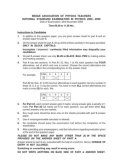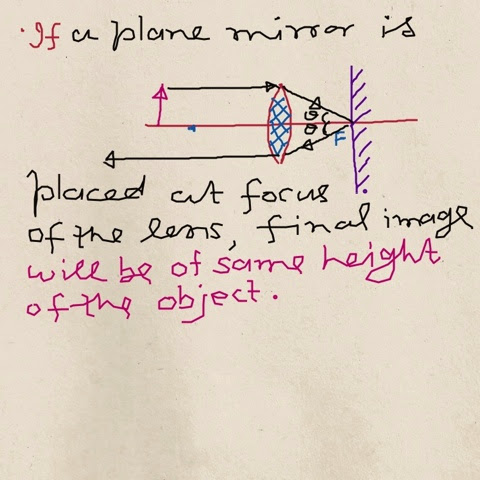Aimed to help students willing to learn physics specially at intermediate level.
Saturday, 25 October 2014
Friday, 24 October 2014
Model test for JEE ..
Here's a link to model test for JEE .Capacitor and current
Sent from my iPad
Check out Physics Paper 2008 Olympiad on Scribd!
I'm currently reading this document on Scribd and thought of you
 Physics Paper 2008 Olympiad http://www.scribd.com/doc/46060803 |
Sent from my iPad
Friday, 3 October 2014
Friday, 19 September 2014
Shared file from Bahnhof
https://secure1.storegate.com/Shares/Home.aspx?ShareID=cc6196d7-09e5-455e-a9be-af08eb1625a5
viresh _iitk has shared a folder with you on SkyDrive
drop 1
Sent from my iPad
Wednesday, 17 September 2014
Shared file from Bahnhof
https://secure1.storegate.com/Shares/Home.aspx?ShareID=2d75692a-209c-48f4-b6f1-174ffb15f0d5
Password protection
If the shared file is protected by a password, please contact the sender.
Do you also want to have an online hard drive? Please visit http://www.storegate.se
Sent from my iPad
viresh _iitk has shared a folder with you on SkyDrive
gdocsviresh
Sent from my iPad
Thursday, 14 August 2014
Monday, 7 April 2014
Success speaks ...
https://m.youtube.com/#/watch?v=aOWQOFrsj0w
Monday, 31 March 2014
Viresh Singh has shared 'Online AIEEE ,26 May 2012...Solution.pdf' with you using Dropbox
Here's a link to "Online AIEEE ,26 May 2012...Solution.pdf" in my Dropbox:
https://www.dropbox.com/s/q0fkxvl4fgfbtol/Online%20AIEEE%20%2C26%20May%202012...Solution.pdf
Sunday, 23 March 2014
Saturday, 22 March 2014
Jee mains :paper 2013 ..23 April online
https://www.dropbox.com/s/6w0xkohd21hlh22/Aieee%20013%20-23%20APRIL.pdf
Following is link to the key for this paper
https://www.dropbox.com/s/cxrqlnjgjn5sdj4/fromiphone.pdf
Thursday, 20 March 2014
Wednesday, 19 March 2014
Tuesday, 18 March 2014
JEE Mains : Test on electro and mag..for jee mains
| |||||||||||||||||||||||||||
JEE Mains ..Some point related to Gravitation
- Speed of a satellite circulating around the earth is independent of it's mass.
- Speed of satellite rotating in larger orbits is lesser.
- If the kinetic energy of a satellite is doubled , it will escape to infinity.
- Polar satellites are used for remote sensing of earth but geostationary satellites are used for the purpose of communication.
- Orbits of geostationary satellite and polar satellites are mutually perpendicular.
- Dimensionally, gravitational potential is same as latent heat.
- If variation of g is accounted for then gravitational potential energy of a particle of mass m raised to height h from earth surface, will gain potential energy by amount. m g h / ( Re +h).
- A satellite rotating around the earth will sweep area at rate L /2M where L is it's angular momentum and M is it's mass.
- Polar satellites have height around 500 to 1000 km above the earth.Their time period is around 2 hrs.
- Taking potential energy zero at infinity, for a satellite rotating around the earth, total energy is negative, potential energy is negative and magnitude of potential energy is twice of that of the magnitude of total energy. Magnitude of the kinetic energy is same as magnitude of the total energy.For example if the kinetic energy is 1000 joules, then total energy will be -1000 joules and potential energy is -2000 joules.
- Any energy of rotating satellite is inversely proportional to the radius of the orbit.
- If the radius of two satellites differ by one percent, then their time periods will differ by 1.5 percent.
JEE Mains :Resolving power
Sunday, 16 March 2014
JEE Mains : Diffraction of light
In case of diffraction of parallel beam of light , around a long narrow slit, following conclusions are important to know for students :
JEE MAINS 14..solved example on KTG.16 March
Ans: 16 P / 25
Solution:

Q. Let there be a vessel of volume V cubic meter ,containing an ideal gas at pressure P0. There is a small hole in the vessel from where the gas is leaking at rate. kV cubic meter per unit time. The temperature is maintained to be constant T and molar mass of the gas is M. Find the pressure after time t.
Solution:
Friday, 14 March 2014
Thursday, 13 March 2014
Tuesday, 11 March 2014
Thursday, 6 March 2014
JEE main 2013 -9april2013online
Here's a link to "Aieee 013 -09 APRIL.pdf" held last year , solve it.
https://www.dropbox.com/s/j7ttb8fovpvltjf/Aieee%20013%20-09%20APRIL.pdf
Here is the link to key .
Link to the key
Wednesday, 5 March 2014
For JEE Mains solved examples 6 Feb 2014
2-All medium particles do not have same energy.
3-Amplitude at distance x from a node is sinusoidal function of position x.
4- When mass m oscillates , it's oscillation energy is equal to half multiplied by mass, square of the angular frequency , square of the amplitude.
4- Consider a small length say dx ,get it's mass and it's oscillation energy and then integrate with respect to x with limits 0 and half wavelength which is distance between nearby nodes.
Sunday, 2 March 2014
JEE MAINS PHYSICS-solved examples-2 march-14
- In the first problem, one can simply conserve the momentum in two directions to reach on the answer. Note that had the collision been head on then there could have been 100% transfer of the energy.
- In the second problem only notable point is that don't use the relation E= hc/ l for electron or any matter to find the wavelength associated with it.
- In third problem the concept here used that beat frequency is the inverse of the time interval of the intensity function.
Good Luck
Saturday, 1 March 2014
Dual Nature and Photoelectric effect
- Photoelectric effect could be
explained satisfactorily after it is assumed that the light consists
of particles which travel with the velocity of light and these particles
have energy and momentum , where energy is proportional to the frequency
of the light and momentum is inversely proportional to the wavelength.
- The behaviour of
light as particle is not a universal i.e. in every situation
the light does not behave as particle but in most situations it behaves as
wave.
- So the light behaving as wave and also as particle, is of dual nature.
- Just like the light has duality in nature, de Broglei proposed that all matter must possesses wave nature also and therefore each matter should be associated with a wave known as de Broglei wave whose wavelength is related to the momentum of the matter in the same manner for the light where l = h / p .
- For photons energy E = h c/ l and effective mass = E/ c2
therefore momentum p = effective mass x c= (E/ c2 ) x c\ p = E/cBut E = hc/ l for photons , so p = (hc/ l )/cor p = h / l - When we calculate wavelength for the matter, we must not use the relation E = hc/ l as this relation is strictly valid only for light. For matters, first calucate momentum and then using the relation l = h / p we can find the deBroglei wavelength.
- For example if we have to find deBroglei wavelength. of an electron of kinetic energy 4 ev , first we calculate its momentum using the relation P= (
2 m E )1/2 and then find its wavelength.
- Specially for the electron, there is a relation 12.27 / ( E )1/2 angstrom where E is the kinetic energy of the electron in the electron volt . So using this relation, we get wavelength of the electron as 12.27/ 2= 6.13 A0 .
- Suppose there is a light consisting of the photons of energy
4 ev and we have to find its wavelength. here we will use the relation E = hc/ l which on simplification comes out to be a simple fomula as l = 12400 / E A0 and so wavelength will be 3100 A0 which is clearly different than wavelength of the electron of same kinetic energy.
- Note that the wavelength associated with the electron is much shorter than that of the photon of same energy.
- Lets compare the de Broglei wavelength of a proton and that of a alpha particle having been accelerated to same electric potential :
Friday, 28 February 2014
Refraction by plane surface and slab
 Here the fig1 shows how rays diverging from a point O placed in a denser medium, appear to come from lesser distant point I , if viewed from rarer medium.
Here the fig1 shows how rays diverging from a point O placed in a denser medium, appear to come from lesser distant point I , if viewed from rarer medium.If the point O is at distance d from the boundary AB, the distance of point I will be d / m .
Fig 2 shows how the rays incident from rarer medium and tending to meet at a point O in the denser medium, gets diverged at the plane boundary and meet at a distant point I .
If the point O is at distance d from the boundary AB, the distance of point I will be m d
Now look at the two situations shown below where a slab of denser medium is refraction the rays which are incident from rarer medium. In first case, the rays are tending to converge at some point
 O but are diverged away to meet at point I after the refraction from both faces of the slab. This shift from O to I can be obtained as t (1-1/m ) where t is the thickness of the slab.
O but are diverged away to meet at point I after the refraction from both faces of the slab. This shift from O to I can be obtained as t (1-1/m ) where t is the thickness of the slab.In the other case where the rays are diverging from a point O, then after refraction by both faces of the slab, the rays are further diverged and appear to come from a point I which is at distance t (1-1/m ) again from the point O.
So a slab of denser medium acts as diverging system !







































